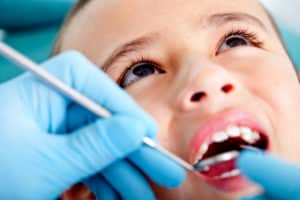Can One Drop of Silver Diamine Fluoride Stop a Cavity?
Your child has a cavity. Is the dental drill a foregone conclusion?
Not necessarily. Silver Diamine Fluoride, sold under the brand name Advantage Arrest™ manufactured by Elevate Oral Care, does a great job of arresting dental caries.
History
Silver Diamine Fluoride (referred to as SDF) is an antimicrobial liquid which has been proven effective in arresting decay. It’s been used in Japan, Australia and a number of other countries for decades as an alternative to the more conventional treatments for cavities as silver nitrate. The U.S. Food and Drug Administration has approved the drug for use in treating oral hypersensitivity, although many dentists are using it as a treatment for cavities under certain circumstances.
How it works

When a decayed tooth is treated with SDF, an impenetrable layer is created. Although the precise mechanism is not fully understood by scientists, it’s thought that the silver compounds kill the pathogens in the decayed portion and therefore arrest further decay. The fluoride in the material acts as a barrier to further acid erosion and actually hardens the dentin.
Uses
SDF is being successfully used for the following:
- Dental hypersensitivity. It provides immediate relief.
- SDF kills pathogenic organisms that cause cavities
- It’s painless to apply
- It hardens soft dentin (the vulnerable layer of the tooth below the enamel) to make it more resistant to cavity-causing acids and does not stain healthy teeth
- Treatment of cavities in children who still have their deciduous (baby) teeth
- An alternative to conventional protocols for patients who are unable to hold still for treatment (due to either physical, developmental or emotional causes)
The Downside
- SDF turns the cavity black, making it aesthetically unappealing to the patient, especially when used on teeth which are visible
- Obviously, it won’t restore function to a compromised or weakened tooth
- A single application may not be sufficient over the long term. In many cases, it’s recommended that the patient be treated a second time in 6 – 18 months
- It’s not ideal for severe cavities – those with holes that trap food and plaque still require fillings.
- It’s not meant to be used as a full-mouth fluoride varnish treatment
- Not many insurance plans cover SDF
- Dental professionals must use caution when preparing the material. Precautions such as eye protection for the patient and covering exposed clothing (which will stain) should be observed
- If a crown or root canal is needed, SDF is not a viable treatment
- If accidentally spilled on a patient’s tongue, SDF has a very unpleasant metallic taste (This should never occur with properly trained staff)
Risks
- The National Institute of Health reports that in over 80 years of use in Japan, no adverse medical effects have been reported
- It cannot be used in patients with an allergy to silver or other heavy-metal ions
- SDF should not be used in patients withoral ulcerations, ulcerative gingivitis or stomatitis.

Benefits
- SDF is a great option in a number of cases, especially in young children and those in nursing homes who might not have their teeth brushed as often as needed
- The material is used in minute quantities – one drop will treat several teeth
- It’s inexpensive when compared to amalgams or composites
- If your child has developmental or physical issues which preclude sitting for long periods, SDF is a stress-free treatment that only requires a few minutes to apply
- In the case of a child who needs sedation for minor procedures, SDF is an excellent alternative
- No shots are needed to administer anesthetics such as Novocaine™
- SDF doesn’t stain healthy teeth
- In the case of children with numerous cavities that cannot be treated in one or two visits, it can be used to stop the progression of the decay until permanent treatment can take place – although it should be noted that no more than 4 or 5 teeth may be treated with SDF per visit.
- While it doesn’t always replace the need for amalgam or composite fillings, it can help to ‘buy time’ if that is of benefit to your child – for example a baby tooth that is months away from coming out on its own.
According to the American Academy of Pediatric Dentistry (AAPD), ‘silver diamine fluoride is being rapidly adopted in graduate pediatric dentistry training programs, with the majority expecting to incorporate it into their teaching clinics and curricula’.
The use of Silver Diamine Fluoride in Pediatric Dentistry requires appropriate training of personnel in the proper storage, preparation, administration and disposal of the material. While we don’t recommend its use in every application, we have found it to be an excellent alternative under certain circumstances. It’s always best to ask your child’s Pediatric Dentist to discuss the best options. Every case, like every child, is unique. We can help you make the best decision for your child.
More information about Silver Diamine Fluoride.













